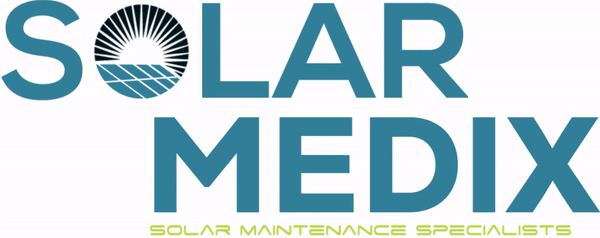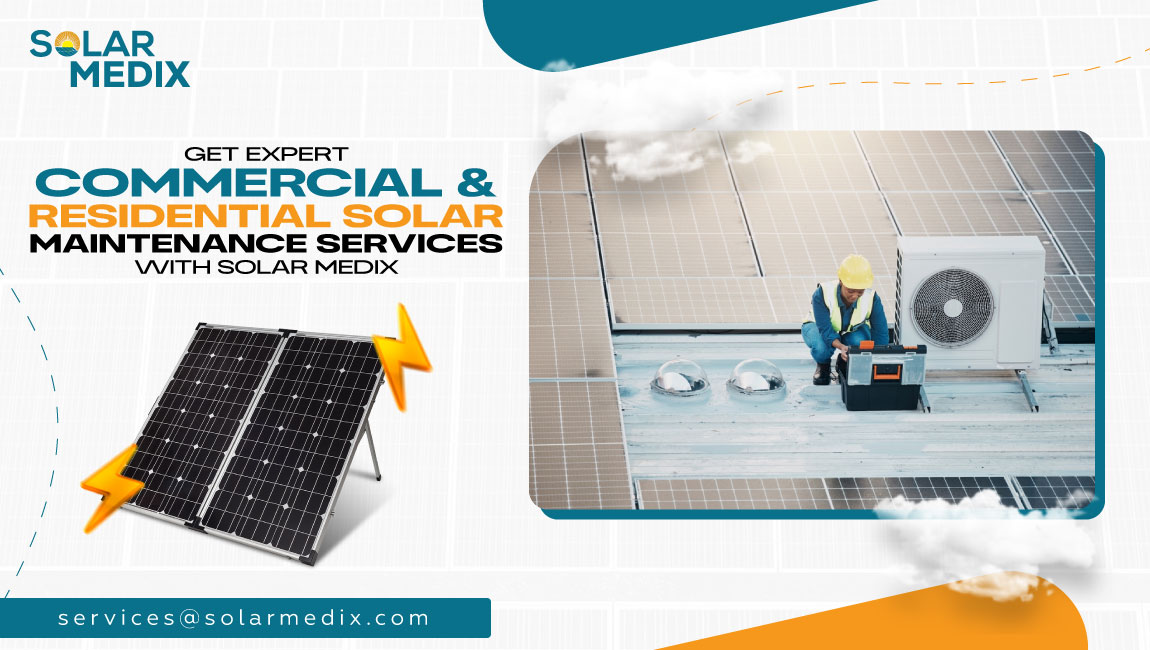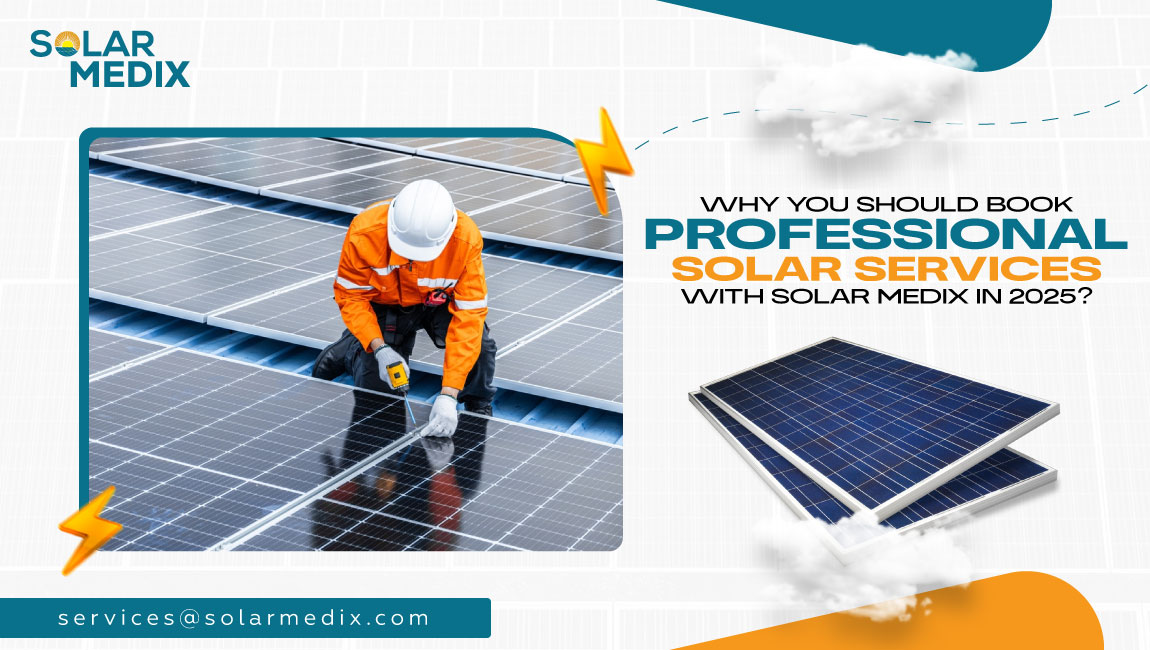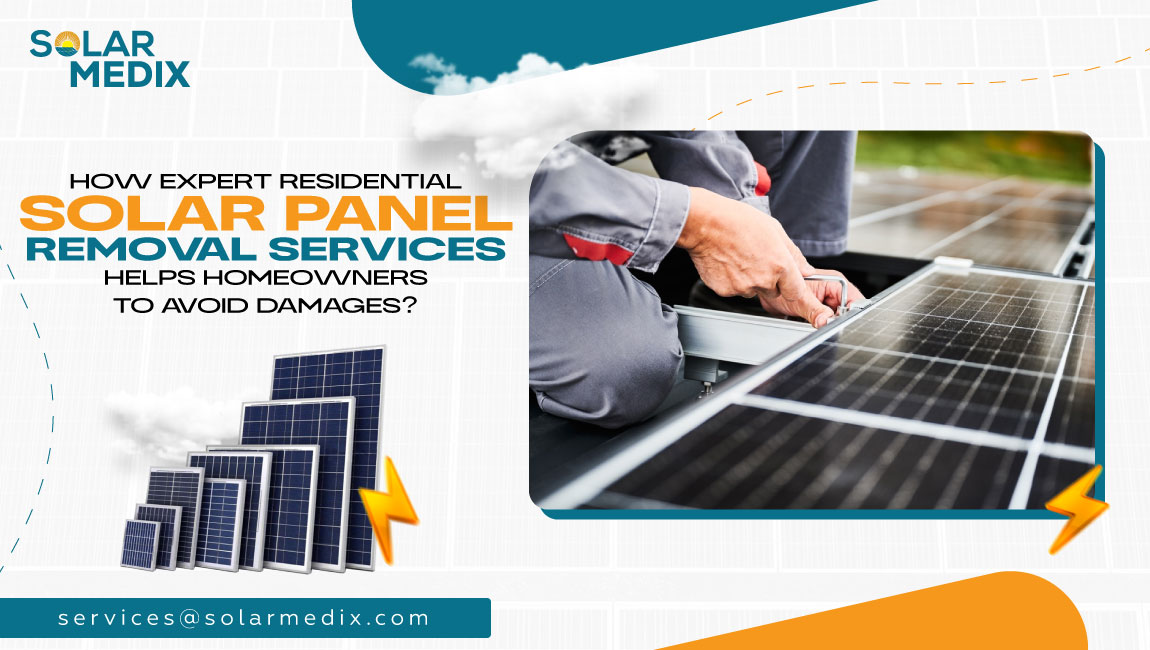At Solar Medix, every day, we work in anticipation of the future to discover the trends and advancements in solar technology. Moving towards 2025, the solar market, similar to the previous years, is experiencing incredible growth.
Besides, these changes are not only revolutionizing the fundamental nature of how people harness solar energy, but they are also, and most significantly, reducing cost while at the same time increasing efficiency.
For homeowners and businesses alike, being aware of these trends will make optimizing their experience with solar systems easier.

Why Solar Technology is the Future
The future of solar technology looks promising, and it is not only related to the ability to collect more solar energy. It is all about improving the efficiency of solar energy, lowering its cost, and spreading it as profoundly as possible throughout society.
Solar technology is emerging as a viable option for clean energy as demand increases for these solutions. However, the ongoing innovations continue to make solar power more affordable, predictable, and sustainable, serving as a cornerstone of global energy strategies for the foreseeable future.
The advancements we witness in 2025 will only open more gates to these shifts, and solar energy will soon be the first choice for homeowners, businesses, and cities.
- Fact: The past year marked a record U.S. solar industry growth, adding 32.4 gigawatts of new electricity generating capacity in 2023, a 37 % increase over the year prior, according to the Solar Energy Industries Association (SEIA). This shows the rapid scaling of solar technology.

Breakthrough Solar Technologies to Watch in 2025
Several new and exciting solar technologies will revolutionize the industry as we look towards 2025. These innovations will lead it toward more efficient panels, intelligent systems, and ultimately, how we generate, store, and consume solar.
Here are five major solar technologies that are ready to take the spotlight,
- Bifacial Solar Panels
- AI-Driven Energy Management
- Advanced Energy Storage Systems
- Smart Solar Systems
- Next-Gen Thin-Film Technology
1. Bifacial Solar Panels
Bifacial solar panels are innovative. Contrary to conventional solar panels that receive light only on one side of the panel, bifacial panels receive light on both the front and the back sides. These additional surfaces can increase the efficiency by as much as 30% more than conventional panels; this makes them quite efficient.
- Higher Energy Output: These panels produce even more electricity by harnessing sunlight reflected off structures, including roofs and the ground.
- Longer Lifespan: Bifacial modules are known to be more robust and make the system capable of handling stronger weather.
- Better Efficiency in Low-Light Conditions: The efficiency of these panels is better during cloudy climates or low-light conditions than conventional panels.
- Increased ROI: The higher energy output means they are among the fastest ways to get a return on investment for residential and commercial purposes.
- Fact: The National Renewable Energy Laboratory (NREL) has revealed that bifacial solar panels could produce up to 9 % more energy than conventional monofacial panels.
2. AI-Driven Energy Management
Solar energy systems are becoming more intelligent thanks to artificial intelligence systems. Innovative energy management using AI assists your solar power system in maximizing the energy it generates and ensures that every single watt is not going to waste.
- Predictive Analytics: Patterns in energy usage can be forecasted using artificial intelligence, which can later be utilized to enhance solar generation and storage systems.
- Energy Optimization: AI can help to increase the efficiency of storing and using energy in your system.
- Automated Maintenance: AI predicts possible failures before they affect the system, decreasing system downtimes.
- More brilliant Energy Usage: Energy can be optimally controlled by AI, which means that over time, you can save more while using less electricity.
3. Advanced Energy Storage Systems
Energy storage is seen as the most influential driver of solar’s advancement. Recent innovations in battery systems indicate that energy storage is rapidly becoming much cheaper and more effective than ever.
- Increased Storage Capacity: New systems will be able to store more energy to ensure that people at home or in business can use solar energy even when the sun is not there.
- Faster Charging and Discharging: Modern batteries charge and discharge faster than the previous ones, making them more reliable.
- Longer Lifespan: Battery technology in solar energy has been improving, cutting the frequency at which storage systems need replacement.
- Lower Costs: Energy storage solutions become more efficient and less costly as the basis for solar-plus-storage solutions expands.
4. Smart Solar Systems
Solar systems will be even more innovative in 2025. They can adapt to specific environmental conditions, regulate energy storage, and even detect and interact with other home or office items.
- Real-Time Performance Monitoring: A corresponding innovative system must be installed to track the efficiency of your solar panels in real time and notify you if there is a problem.
- Automated Adjustments: Such systems will adjust and control energy demand and supply for optimum energy utilization.
- Integration with Smart Homes: Smart solar systems will also be compatible with other smart home systems, which means that all your devices will be managed in terms of energy use.
- Remote Troubleshooting: Smart systems can detect problems, thus minimizing situations that require Solar Medix to send crews to customers’ sites.
5. Next-Gen Thin-Film Technology
Thin-film solar panels are versatile, portable, and cheaper than silicon-based thick-film solar panels. As this technology advances, it will significantly impact the solar industry.
- Flexibility: The curved and irregularly shaped surfaces can also be covered with thin film panels.
- Lower Production Costs: Producing thin-film panels is cheaper, so solar energy may be more affordable.
- Greater Efficiency: Recent developments in new thin-material and fabrication technologies are making thin-film panels more cost-effective than the silicon industry.
- Versatility: These panels are advantageous for uses where standard panels do not fit, such as portable solar solutions or integrated building facades.

Environmental & Economic Impact of Upcoming Solar Technologies in 2025
Solar systems will not only be able to expand the range of possibilities but also bring tremendous cost advantages. The developments in 2025 will immensely help protect the environment and enhance the global economy.
Here’s how they will help the earth and your wallet,
- Lower Costs for Consumers
- Sustainability and Carbon Footprint Reduction
- Long-Term Savings for Homeowners and Businesses
- Resource Efficiency in Solar Production
1. Lower Costs for Consumers
The drop in the cost of installing solar systems continues as technology improves. More efficient panels, intelligent systems, and better storage options will mean lower upfront costs and higher savings over long periods.
- Decreased Installation Costs: New solar panels are more efficient, allowing the same amount of electricity produced by fewer panels, hence cheaper installation costs.
- Affordable Storage Solutions: Battery technology will improve, and the battery system will become cheaper, allowing more people to access stored energy from the sun.
- Government Incentives: Policies like the Inflation Reduction Act (IRA) will continue to make solar accessible for consumers while keeping costs as low as possible.
2. Sustainability and Carbon Footprint Reduction
Solar power is already widely considered one of the safest and cleanest forms of energy, but the prospects for 2025 are even greener.
- Reduced Carbon Emissions: Solar energy use also decreases dependence on fossil fuels, lowers carbon footprint, and helps fight climate change.
- Greener Manufacturing Processes: Advancements in solar panel production technology will decrease energy costs by making manufacturing more sustainable.
- Sustainable Materials: Next-generation solar panels will be manufactured with less hazardous materials to the environment, minimizing the harm done during their production.
3. Long-Term Savings for Homeowners and Businesses
Even though solar panels will necessitate sizeable initial investments, there is no denying the long-term savings they would render. Furthermore, advancements in technology will only bolster those savings.
- Lower Energy Bills: Efficient and advanced solar systems and noteworthy energy storage devices can eliminate or significantly reduce the energy bills incurred by homes and businesses.
- Increased Property Value: The value of properties will go up due to the installation of solar panels, making it an excellent investment for the future.
- Financial Incentives: Rebates and tax credits provided by the government and financial plans will make solar energy even more straightforward for businesses and homeowners.
4. Resource Efficiency in Solar Production
Solar energy efficiency isn’t restricted to only the energy produced. Its improvements also cover the equipment manufacturing processes to enhance resource efficiency further.
- Less Material Waste: Manufacturing processes adopting technologically advanced materials such as perovskite solar cells are expected to cut significantly the waste produced during production.
- Lower Water Use: Compared to traditional methods of energy production, solar panels consume less water in their production process, which is an added advantage.
- Recyclable Materials: Future advancements in solar panel design are expected to raise the proportion of recyclable materials, guaranteeing that solar energy will be clean, sustainable, and environmentally friendly throughout its life span.

Challenges to Adopting New Solar Technologies
The future of solar technology might be promising, but technical challenges need to be worked on and solved, which would encourage these advancements to be accepted.
Here are some challenges we may face going into 2025 and beyond,
- Initial Costs of Emerging Solar Innovations
- Infrastructure Gaps for Advanced Solar Systems
- Compatibility with Existing Energy Grids
- Complex Regulatory Requirements for Next-Gen Solar
1. Initial Costs of Emerging Solar Innovations
One major hurdle to overcome when integrating new technologies is the initial investment cost, which poses a problem for individual owners and small enterprises. Even though prices tend to decrease, the physical size of the structures being built, such as bifacial panels and energy storage systems, tends to be quite costly.
- Higher Equipment Costs: The initial construction price for new solar technologies makes many prospective buyers hesitant to purchase.
- Installation Costs: Some installations requiring different methods and tools have raised the installation’s labor cost.
- Limited Financing Options: Financing for emerging technologies is weaker and less robust than traditional forms.
2. Infrastructure Gaps for Advanced Solar Systems
Infrastructure must evolve alongside these new solar technologies. Some regions or microgrids may need to be upgraded to serve new technologies, especially those that rely on energy storage and more intelligent systems.
- Grid Compatibility: There are more advanced solar systems that may not be compatible with the existing electrical grids and will thus require expensive upgrades.
- Storage Limitations: As more energy storage systems are deployed, new infrastructure will be needed to store and manage energy effectively.
- Maintenance and Support: Enhanced new technologies will burden service providers in terms of offering maintenance services.
3. Compatibility with Existing Energy Grids
Integrating new solar technologies with energy grids can be difficult. The grid can’t handle solar power, not to mention battery storage and innovative systems.
- Grid Integration Challenges: Controlling the flow of solar energy, storage data, and energy distribution between homes, businesses, and the grid is a big job done through complex control systems to keep things operating smoothly.
- Energy Market Adaptation: Integration of solar may pose challenges in some regions, as existing energy markets were not designed for new renewable sources, leading to inefficiencies and disruptions.
- System Incompatibility: Advanced solar systems, including smart solar and energy storage solutions, may not be readily compatible with older infrastructure, potentially reducing system performance.
- Investment in Grid Modernization: Smart solar and energy storage systems may not provide optimal results in conjunction with older systems due to compatibility concerns.
4. Complex Regulatory Requirements for Next-Gen Solar
Experiences with regulating solar energy technologies and infrastructure reveal that regulation changes over time and often lags behind developing technologies. Continuum solar technologies will likely encounter compliance constraints associated with emerging rules and regulations.
- Slow Regulatory Adaptation: The evolution of regulations about emerging solar technologies might take some time, which could disrupt their deeper market penetration and merger with existing energy systems.
- Permitting and Zoning Challenges: Installing new solar power systems can be a significant difficulty for individuals and businesses when such incorporated systems are accompanied by zoning law restrictions.
- Varying Regulations by Region: Businesses and even individuals aiming for further advancement in solar technologies are surrounded by confusion courtesy of varying regulations across different states and countries.
- Need for Policy Updates: Strong government policies must be implemented to overcome those hurdles in advanced solar power technologies. Such measures must provide explicit directives to the market, ensuring smooth system deployment and fostering industry innovation.

What Solar Technologies Mean for Solar Medix Clients
As experts in solar maintenance, we at Solar Medix understand the importance of staying ahead of the curve. By 2025, developing new solar technologies will render our clients’ solar systems more reliable, efficient, and cheaper.
Besides, we will always offer the highest level of customer service and support so that every customer’s solar, energy storage systems, and other devices are at their peak efficiency at any point in time.
Our team is available for maintenance and regular inspections of complex upgrades. As we bring in these new technologies, the promise is that your solar system will continue to be as efficient and dependable for years to come!
Trying to make the right choice for your solar installation? Before signing on the dotted line, you must understand your agreement. Check out our blog, 5 Things to Know Before Signing a Solar Contract.
Frequently Asked Questions (FAQs)
The latest solar technologies are Perovskite solar cells, AI-powered energy management systems, advanced energy storage solutions, and cutting-edge thin-film panels. These innovations promise to make solar energy more efficient, affordable, and accessible.
According to expectations, existing solar technologies will become cheaper in the short run and save consumers much more in the long run; furthermore, they will likely be more affordable and efficient. This will eventually increase market penetration, boost competition, and further contribute to the economy's growth, specifically focusing on green energy.













